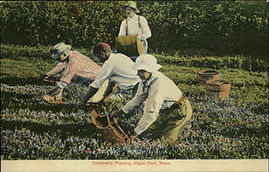Restoring the River
Background
The Coonamessett River Valley in Falmouth, Massachusetts has seen dramatic changes over the last 400 years, primarily due to evolving use by people. For thousands of years, Native Wampanoag gathered the abundant natural resources, with little long-term impact. Arrival of European settlers in the 1600s began a series of alterations to the river that would span centuries. Use of water power to fuel grist- and then woolen mills, then conversion to cranberry farming, had a profound impact on the river and surrounding wetlands. Once host to throngs of herring, American eel, and Brook trout, fish populations had dwindled to almost nothing by the 1900s. Other animal and plant communities also changed considerably.
Restoring health to the Coonamessett River and its bordering wetlands has been a long-term goal of local, state and federal biologists for at least 30 years.In the early 2000s, two local non-profits began working to make this goal a reality. Coonamessett River Trust (CRT) began systematic monitoring of biological, chemical and physical characteristics of the river. The 300 Committee Land Trust of Falmouth (T3C), sometimes working with the Town of Falmouth, began strategically targeting land along the river for acquisition, to create a vegetated buffer along the river from Coonamessett Pond, almost to Great Pond.
Project goals are to:
-
establish a healthy, self-sustaining river and wetland ecosystem that supports fish, other aquatic organisms, and wildlife;
-
increase resiliency of the coast as storms get stronger, by removing blockages and creating connection to the floodplain.
-
increase recreational and educational opportunities for people of all ages to discover the environmental, land use, and cultural history surrounding the river.
Active restoration began in 2017 with Phase 1 (Dexter's Mill Crossing to Middle Dam) completed in 2018. Phase 2 (Swift's Crossing – formerly Middle Dam – to Pond 14 and a new culvert/bridge at John Parker Road Crossing) is currently underway, slated to be finished in spring 2020.
Results to date
Results in Phase 1 of our first two goals have exceeded the expectations of even seasoned scientists. One of the most fascinating aspects was that seeds from wetland plants that had been buried for 300 years under mill ponds and cranberry bogs sprung to life once original wetland soils were uncovered.
CRT, with the help of T3C, is achieving the third goal. Learn more about our educational programs here. A trail – the Coonamessett Greenway Heritage Trail – now runs about 3.5 miles along both sides of the river with multiple loops along the way.
Watch a video describing the restoration and results of Phase 1.

Brass Plaque: Sarah Peters
Photos: Courtesy Falmouth and Woods Hole Historical Societies.



Our Concerns about the Saxon Partners Project
The CRT is very concerned about the potential impacts of the 300 unit 40B development proposed by the Saxon Partners Project at 375 Sandwich Rd. This project will disrupt wildlife corridors between upland areas and the Coonamessett's river habitat. If the stormwater basins aren't properly sized or maintained at this massive development, the overflow could bring phosphorus pollution to the river causing algal blooms. The biggest concern is the large amount of nitrogen that would be carried downstream to the already severely impacted Great Pond Estuary.
Please read our letter outlining our concerns to the Zoning Board of Appeals, the Town committee reviewing the project.

Photos: Alison Leschen
Coonamessett River before, during, and after restoration.


